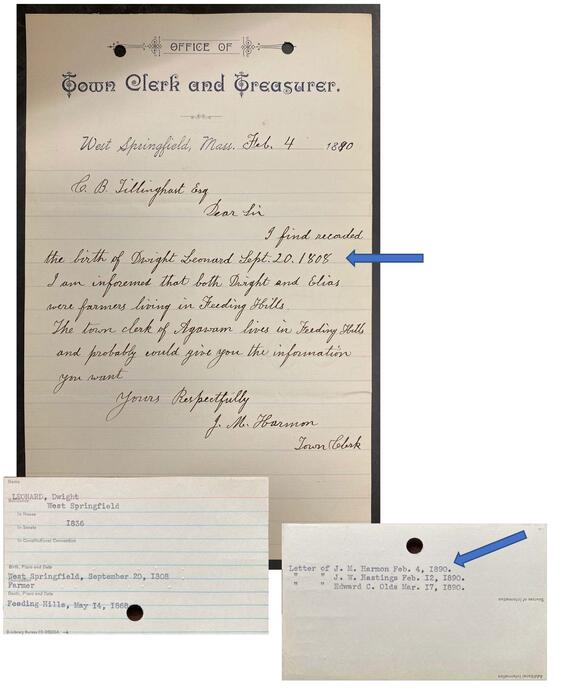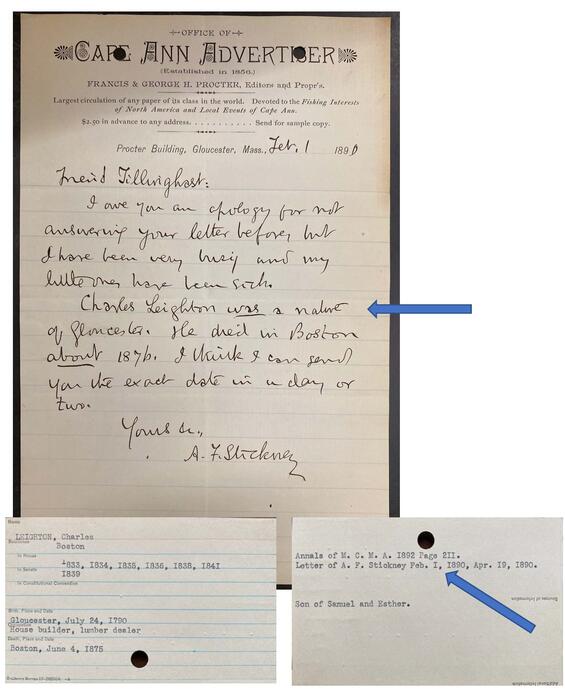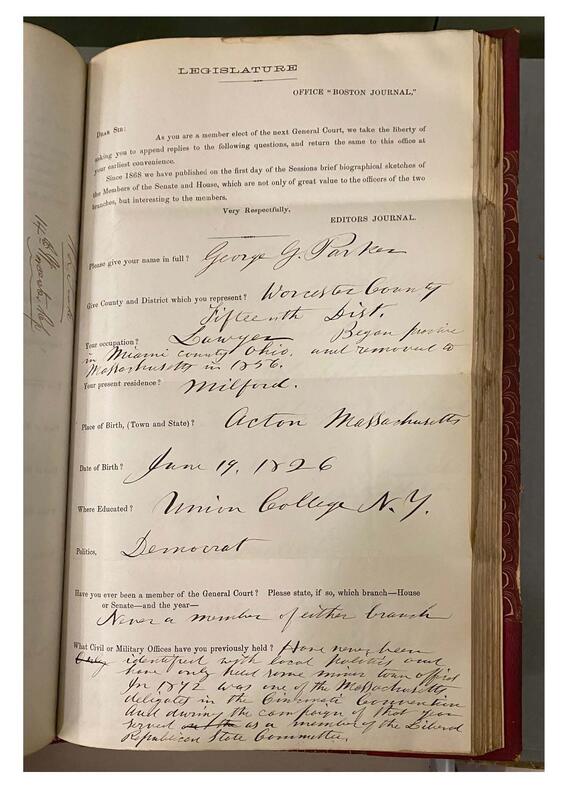Overview
The State Library has two legislative biographical files made up of typed and/or handwritten index cards. The card file in the Main Reading Room of the State Library spans the colonial era to the present day and the card file in the Special Collections Department spans the late eighteenth century to about 1915. The card files contain biographical information about past and present-day Massachusetts legislators and may contain information on both the front and back sides of each card.
Many of the cards contain references to letters. The letters are held in the legislative biographical file in the Special Collections Department of the State Library. This collection, made up of cards and manuscript letters, comprises what is called Manuscript 151.
These card files were previously only available for in-library use by researchers. The cards themselves were digitized, and the information was transcribed into electronic form to create a searchable database. The images of the cards will also be linked to the entry for each legislator. The goal is to link all State Library collections, print and non-print, relating to individual legislators for a one-stop searching experience.
*All card information is subject to verification
*Known bug substituted 1/1/1900 for birth/death dates that should be blank. These are being updated
Search the Legislator Database
Choose "Search State Library" and the following are the searchable fields in the database:
- First Name
- Last Name
- Years Served From
- Years Served To
- Hometown
- Party
- Chamber
Sources of Information
Manuscript 151
This consists of the correspondence of Caleb Benjamin Tillinghast, State Librarian, related to the legislative biography file. The letters referenced on the individual cards have been digitized and will be linked to the database entry for the legislator. These are some examples of how the letters and cards interrelate.


Manuscript 138
Memoranda relating to the members of the General Court, 1868-1892, obtained by the Boston Journal.
This is a collection of printed questionnaires sent to members of the General Court for the purpose of collecting information for biographical sketches to be published in the Boston Journal, with replies in manuscript. List of survey questions vary slightly from volume to volume, and concern county and district served, occupation, place of residence, place and date of birth, place educated, political party, previous service in the General Court, and previously held civil or military offices. These memoranda have been digitized and will be linked to the database entry for the legislator. This is an example of a questionnaire.

Notes on Political Parties
The state did not officially record political parties before 1895, when the modern form of Public Document #43 begins. Fortunately, the biographical sketches in the Boston Morning Journal list parties for most legislators starting in 1868 as does the Massachusetts Legislative Souvenir which was issued privately starting in 1892.
Before 1868, the major source for political affiliations are the newspapers reports of party nominations, election returns, and the annual state conventions. Before 1832, there was such a multiplicity of election days that newspapers tended to lose interest in the election once it was definite as to which side had won control of the legislature. Newspapers stopped reporting election returns and it is often impossible to figure out the political affiliation of those who were elected at the end of the election period.
The situation was supposedly simplified with the tenth amendment to the Massachusetts Constitution in 1831 which moved all elections to November. However, since a majority vote was still required for election, towns continued to have multiple town meetings. The state mandated that all elections for representatives be held within three days of the voting for governor, with an extra opportunity on the fourth Monday in November. But again, newspaper editors continued to ignore late returns, except where the race was extremely close, so there continue to be “unknowns” in the legislature.
Even after the current district system was adopted in 1858, towns which were late in counting their ballots might not be covered by the newspapers.
Many legislators can be identified by party because of previous or subsequent elections. Those who only served a single term and especially those who were elected as replacements for colleagues who died or resigned, are often impossible to obtain information on.
Notes on Massachusetts State Elections
State elections have changed radically since the Massachusetts Constitution was put into place in 1780. State senators, for example, were originally meant to represent the taxes paid by a county rather than the number of people. This was John Adams’ concept establishing an economic aristocracy in a democracy to counterbalance the lower house which represented the common people. All senators were chosen on county wide tickets, and sometimes in multi-county districts, at the state election in early April. In no candidate obtained a majority of the votes for any office, the members of the incoming legislature determined which candidate won from about the top two vote getters in that particular contest.
Starting in 1840, Senators represented numbers of people rather than taxes paid. Only a plurality of votes was necessary for election starting in 1856 while the modern system of districts for Senators went into effect in 1858.
Members of the House of Representatives were elected sometime in May before 1832 and usually represented only one town. Under a series of constitutional amendments, elections were moved to November and the number of people necessary to elect a representative was raised. In addition, towns with small populations had representation in the legislature for only part of a decade after 1837.
This system lasted till the twenty-first amendment was ratified in 1857, and Massachusetts switched to a district system. The House of Representatives was set at 240 members, with each member representing what was supposed to be an equal number of people. Massachusetts reduced the number of representatives to 160 in 1979 but otherwise has maintained the same system since 1858.
Contact
Online
Phone
Open M-F 9 a.m.–5 p.m.
Open M-W 9 a.m.–5 p.m. Closed Th-F *Advance appointments highly recommended
